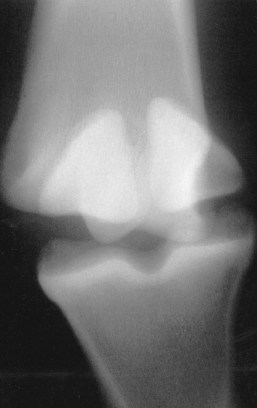Chapter 67Other Joint Conditions
Diseases of Soft Tissues of the Joint
Soft tissue structures serve to support the joint, and disease can result in abnormal stresses to the articular cartilage and hence chronic progression of articular cartilage degeneration and osteoarthritis (OA) (see Chapter 61). Preoperative diagnosis of some soft tissue injuries is difficult, often leaving the surgeon with little to do other than evaluate the injured area and debride fibrillated tissue during arthroscopic surgery. With the advent of newer diagnostic techniques such as magnetic resonance imaging (see Chapter 21) and increased use of ultrasonography (see Chapter 17), soft tissue injuries can be characterized better preoperatively.
Most soft tissues of joints, such as ligaments, menisci, and joint capsules, function to support joints. Joint ligaments maintain alignment of opposing and adjacent bones in joints. They form a connection between opposing bones (such as the tibia and femur in the stifle) and between adjacent bones in more complex joints (such as between the carpal bones). They function to maintain alignment and allow for movement of the joint. The meniscal cartilages function as cushions between the tibia and femur of the femorotibial joints. Proper material characteristics are necessary for maintenance of the joint environment. The joint capsule is also responsible for maintaining joint support and provides a barrier for synovial fluid. Because the capsule surrounds the entire joint, appropriate elasticity is needed to maintain joint flexibility (see Chapter 66).
Ligament Injuries
Joint ligament injury can be an incidental finding during surgery or a devastating cause of lameness. For instance, medial palmar intercarpal ligament damage can be an incidental finding during arthroscopic surgery and has been seen incidentally in necropsy specimens (see Figure 23-4 and Chapter 38).1
Injury to cruciate ligaments and menisci of the stifle usually causes substantial pain (see Chapter 46), but cutting the cranial cruciate ligament in an attempt to create a model of OA did not lead to OA in horses. Therefore further destabilization of the joint beyond cruciate injury must usually occur, with possible damage to other soft tissue structures, including the joint capsule.
Collateral ligament injury caused by a bad step or laceration can result in subtle or severe lameness. I have seen low-grade lameness in a horse that had complete tearing of the medial collateral ligament of the metatarsophalangeal joint (Figure 67-1). Laxity of the joint was detected by manipulation and stress radiographs. The joint was immobilized in a cast for 6 weeks, followed by use of a splint for an additional 6 weeks. Reinjury occurred after splint removal, and the joint was recast. After immobilization for 16 weeks the injury healed well enough for trail riding. Others have described collateral ligament abnormalities in the carpus and its close association with OA.2




